Themed collection Soft Matter Emerging Investigators Series

Morphogenesis of confined biofilms: how mechanical interactions determine cellular patterning and global geometry
Bacterial biofilms that grow under confinement can mechanically interact with their environment to generate various global geometries and forms of cellular patterning.

Soft Matter, 2025,21, 1436-1450
https://doi.org/10.1039/D4SM01180E
Predicting polymer solubility from phase diagrams to compatibility: a perspective on challenges and opportunities
Advances in physical models and data science are improving predictions of polymer–solvent phase behavior and we discuss the different approaches taken today and the remaining barriers to making broadly useful predictions.

Soft Matter, 2024,20, 5652-5669
https://doi.org/10.1039/D4SM00590B
The sweetest polymer nanoparticles: opportunities ahead for glycogen in nanomedicine
Glycogen is a biomaterial nanoparticle composed of sugar. In this perspective, the opportunities of glycogen in nanomedicine going forward is discussed.

Soft Matter, 2024,20, 3577-3584
https://doi.org/10.1039/D4SM00261J
A new order of liquids: polar order in nematic liquid crystals
Given the widespread adoption of display technology based on nematic liquid crystals, the discovery of new nematic phases at thermodynamic equilibrium, although extremely rare, generates much excitement.

Soft Matter, 2022,18, 5014-5020
https://doi.org/10.1039/D2SM00543C
Ion-conducting polymer thin films via chemical vapor deposition polymerization
Ion-conducting polymers (ICPs) are gaining interest in various scientific and technological fields. This review highlights advancements in ICP thin films using chemical vapor deposition (CVD) and addresses challenges of traditional methods.

Soft Matter, 2025,21, 1813-1834
https://doi.org/10.1039/D4SM01346H
Lipid lateral diffusion: mechanisms and modulators
Various models of lipid lateral diffusion which gives distinct shapes of quasielastic neutron scattering spectra: ballistic motion – Gaussian, continuous/jump diffusion – Lorentzian, and confined diffusion – combined elastic and Lorentzian.

Soft Matter, 2024,20, 7763-7796
https://doi.org/10.1039/D4SM00597J
Theory and simulation of ligand functionalized nanoparticles – a pedagogical overview
Synthesizing reconfigurable nanoscale synthons with predictive control over shape, size, and interparticle interactions is a holy grail of bottom-up self-assembly.

Soft Matter, 2024,20, 3554-3576
https://doi.org/10.1039/D4SM00177J
Worm blobs as entangled living polymers: from topological active matter to flexible soft robot collectives
Living worms form “blobs,” active entangled physical structures with emergent properties. We show how these worms provide a fascinating platform to study active polymer physics.

Soft Matter, 2023,19, 7057-7069
https://doi.org/10.1039/D3SM00542A
Fluid manipulation via multifunctional lubricant infused slippery surfaces: principle, design and applications
Water-repellent interfaces with high performance have emerged as an indispensable platform for developing advanced materials and devices.

Soft Matter, 2023,19, 588-608
https://doi.org/10.1039/D2SM01547A
Solvent-assisted self-assembly of block copolymer thin films
Solvent-assisted block copolymer self-assembly is a compelling method for advancing practical applications of these materials due to the exceptional level of the control of BCP morphology and significant acceleration of ordering kinetics.
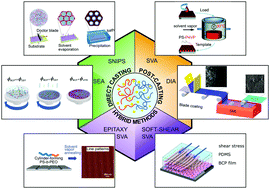
Soft Matter, 2022,18, 4042-4066
https://doi.org/10.1039/D2SM00439A
Computer simulations of entropic cohesion in reversibly crosslinked polymers
The mass density is a key controllable variable in polymers with dynamic crosslinkers, one that can be used to facilely tune their properties.

Soft Matter, 2025,21, 348-355
https://doi.org/10.1039/D4SM01161A
An organic/inorganic hybrid soft material for supramolecular adhesion
An organic/inorganic hybrid supramolecular adhesive with 3D printing capacity was prepared from low-molecular-weight monomers.

Soft Matter, 2024,20, 5670-5674
https://doi.org/10.1039/D4SM00501E
Quantifying the trade-off between stiffness and permeability in hydrogels
Hydrogels have a distinct trade-off between mechanical stiffness and water permeability due to the spacing of polymer strands.
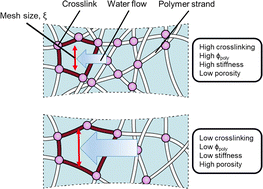
Soft Matter, 2022,18, 7735-7740
https://doi.org/10.1039/D2SM01215D
A simple simulation-derived descriptor for the deposition of polymer-wrapped carbon nanotubes on functionalized substrates
Analysis of solvent structure obtained from all-atom molecular dynamics simulations reveals a descriptor that predicts the experimental deposition of polymer-wrapped carbon nanotubes.
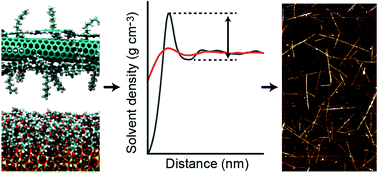
Soft Matter, 2022,18, 4653-4659
https://doi.org/10.1039/D2SM00572G
Repulsive torques alone trigger crystallization of constant speed active particles
Active particles which repel each other through torques crystallize without reducing their intrinsic speed.
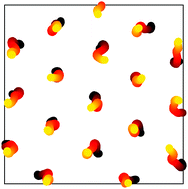
Soft Matter, 2022,18, 3120-3124
https://doi.org/10.1039/D2SM00256F
Temperature-dependent reentrant phase transition of RNA–polycation mixtures
In this letter, we report that RNA–polycation mixtures display a temperature-controlled dual-response phase behavior with concurrent UCST and LCST transitions.

Soft Matter, 2022,18, 1342-1349
https://doi.org/10.1039/D1SM01557E
Temperature switchable self-propulsion activity of liquid crystalline microdroplets
We report on a switchable emulsion droplet microswimmer by utilizing a temperature-dependent transition of the droplet phase.

Soft Matter, 2025, Advance Article
https://doi.org/10.1039/D4SM01382D
Towards electrospray-assisted production of lipid-based synthetic cell assemblies
This study reports the development of an electrospray-based technique (ATLAES) using all-aqueous systems to form a rich variety of microscopic vesicles, with nebulous to smooth lipid coatings, providing a new platform for engineering synthetic cells.

Soft Matter, 2025,21, 2977-2985
https://doi.org/10.1039/D4SM01284D
Quantifying and understanding the tilt of a Pt Janus active colloid near solid walls
Chemically powered Janus active colloids move near solid boundaries with their catalytic caps tilted away from the wall, due to activity-induced torques.

Soft Matter, 2025, Advance Article
https://doi.org/10.1039/D5SM00073D
Reshapable magnetic particles for morphology-controlled soft systems
Magnetic-loaded polymeric microparticles with exceptional malleability are fabricated using a simple emulsion evaporation method. These composite particles retain their magnetic functionality while being mechanically reshaped into ellipsoids.

Soft Matter, 2025, Advance Article
https://doi.org/10.1039/D5SM00061K
Composition–structure–property relationships of polyethylene vitrimers crosslinked by 8-arm polyhedral oligomeric silsesquioxane
This study examines the effects of crystallinity, crosslinking, and network design on polyethylene-derived vitrimers using multifunctional nanoparticle-based crosslinkers.

Soft Matter, 2025,21, 2694-2703
https://doi.org/10.1039/D4SM01518E
The underappreciated role of nonspecific interactions in the crystallization of DNA-coated colloids
Nonspecific interactions between DNA-coated colloidal particles play a critical role in determining the stabilities of competing crystal polymorphs.

Soft Matter, 2025,21, 2654-2663
https://doi.org/10.1039/D5SM00001G
Sub-Newtonian coalescence dynamics in shear-thickening non-Brownian colloidal droplets
Sub-Newtonian coalescence dynamics exhibited by non-Brownian shear thickening colloidal droplets beyond a critical particle weight fraction.

Soft Matter, 2025, Advance Article
https://doi.org/10.1039/D4SM01389A
Adhesion study at the interface of a PDMS-elastomer and borosilicate glass-slide: effect of modulus and thickness of the elastomer
Adhesion control at the interface of two surfaces is crucial in many applications.

Soft Matter, 2025,21, 2493-2501
https://doi.org/10.1039/D4SM01249F
Sampling the large-dimensional energy landscape of a 2D granular system with the hydra string method
In this work, I improve upon the existing hydra string method [C. Moakler and K. A. Newhall, Granular Matter, 2021, 24, 24] to systematically sample the energy landscape of a low friction 2D granular system.

Soft Matter, 2025, Advance Article
https://doi.org/10.1039/D4SM01337A
Reinforcement learning selects multimodal locomotion strategies for bioinspired microswimmers
Reinforcement learning enables a bioinspired microswimmer to select locomotion strategies based on different functional tasks such as multidirectional navigation.

Soft Matter, 2025,21, 2363-2373
https://doi.org/10.1039/D4SM01274G
Microrheological model for Kelvin–Voigt materials with micro-heterogeneities
We introduce a generalization of the Kelvin–Voigt model in order to include and characterize micro-heterogeneities in viscoelastic semisolid materials.

Soft Matter, 2025,21, 1498-1507
https://doi.org/10.1039/D4SM01474J
Physical scaling for predicting shear viscosity and memory effects of lithium-ion battery cathode slurries
Using rheo-electric measurements, we revealed a power-law scaling that quantitatively describes the shear rheology of lithium-ion battery slurry, and identified shear-induced structure memory through the carbon-phase electrical conductivity.

Soft Matter, 2025,21, 1489-1497
https://doi.org/10.1039/D4SM01493F
Dynamic electroosmotic flow and solute dispersion through a nanochannel filled with an electrolyte surrounded by a layer of a dielectric and immiscible liquid
The present article deals with the modulation of oscillatory electroosmotic flow (EOF) and solute dispersion across a nanochannel filled with an electrolyte solution surrounded by a layer of a dielectric liquid.

Soft Matter, 2025,21, 1085-1112
https://doi.org/10.1039/D4SM01255K
Linking structural and rheological memory in disordered soft materials
Hybrid rheo – X-ray photon correlation spectroscopy is used to show nanoscale structural memory can be determined by bulk recoverable strain.

Soft Matter, 2025,21, 750-759
https://doi.org/10.1039/D4SM00953C
Non-monotonic frictional behavior in the lubricated sliding of soft patterned surfaces
We study the lubricated contact of sliding soft surfaces that are locally patterned but globally cylindrical, held together under an external normal force.

Soft Matter, 2025,21, 448-457
https://doi.org/10.1039/D4SM01018C
Ultrahigh yields of giant vesicles obtained through mesophase evolution and breakup
We report the discovery of a novel mechanism for the assembly of giant unilamellar vesicles, where fluid shear-induced fragmentation of a foam-like lamellar lipid mesophase occurs in lipid mixtures containing 3 mol% PEG2000-DSPE.

Soft Matter, 2024,20, 9547-9561
https://doi.org/10.1039/D4SM01109K
Towards a universal model for the foaming behavior of surfactants: a case study on per- and polyfluoroalkyl substances (PFAS)
Foam fractionation offers a promising solution for the separation of surface-active contaminants from water.

Soft Matter, 2024,20, 9343-9359
https://doi.org/10.1039/D4SM00931B
Liquid crystalline collagen assemblies as substrates for directed alignment of human Schwann cells
Collagen is a key component of the extracellular matrix (ECM) and well-oriented domains of collagen are important for mimicking the local cell environment in vitro. Here, we demonstrate macroscopic alignment on collagen in 2-D substrates and 3-D hydrogels.

Soft Matter, 2024,20, 8997-9006
https://doi.org/10.1039/D4SM00534A
Active nematics in corrugated channels
In corrugated channels, active nematics transition from counter-rotating swirls to coherent flows. Swirling structures in the corrugations facilitate slip, lowering the critical activity needed for the transition.

Soft Matter, 2024,20, 8230-8245
https://doi.org/10.1039/D4SM00760C
Probing the physical origins of droplet friction using a critically damped cantilever
Critically damped droplet force apparatus enables high-speed friction measurements on superhydrophobic surfaces without ringing artefacts. This reveals a new regime, where Ffric ∝ U2/3, due to viscous dissipation in the air layer during lift-off.

Soft Matter, 2024,20, 7583-7591
https://doi.org/10.1039/D4SM00601A
Thermodynamics description of startup flow of soft particles glasses
Structural anisotropy in shear flow and its effect on the excess entropy of soft pastes.

Soft Matter, 2024,20, 7387-7396
https://doi.org/10.1039/D4SM00514G
Computational investigation of the effects of polymer grafting on the effective interaction between silica nanoparticles in water
Altering solvent-mediated effective interaction between silica nanoparticles in water through polymer grafting.

Soft Matter, 2024,20, 7122-7132
https://doi.org/10.1039/D4SM00512K
Elucidating the role of physicochemical interactions on gel rheology
Bond kinetics and network restructuring in gels control their yield transition and thixotropic recovery.

Soft Matter, 2024,20, 7094-7102
https://doi.org/10.1039/D4SM00516C
Phoresis kernel theory for passive and active spheres with nonuniform phoretic mobility
Phoresis kernels define the local contribution of driving field or flux to the overall translational and rotational dynamics of the microswimmer.

Soft Matter, 2024,20, 6907-6919
https://doi.org/10.1039/D4SM00360H
Controlling the thermally-driven crystallization of DNA-coated nanoparticles with formamide
DNA-driven assembly of colloidal crystals often requires annealing at temperatures that can damage DNA-nanoparticle bonds. Here we show that regulating assembly thermodynamics with DNA denaturants enables crystallization under ambient conditions.

Soft Matter, 2024,20, 6723-6729
https://doi.org/10.1039/D4SM00854E
Asymmetric toughening in the lap shear of metamaterial structural adhesives
Metamaterial structural adhesives with a thick asymmetric backing and thin adhesive layer offer superior advantages over traditional uniform adhesives, including enhanced adhesion due to the crack trapping mechanism and asymmetric properties.

Soft Matter, 2024,20, 6568-6581
https://doi.org/10.1039/D4SM00410H
Quantitative turbidimetric characterization of stabilized complex coacervate dispersions
The stabilization of complex coacervate microdroplets can be modulated by the concentrations of cPE stabilizer and salt, enabling their various applications, such as bioreactors, drug delivery vehicles, and encapsulants.

Soft Matter, 2024,20, 5060-5070
https://doi.org/10.1039/D3SM01761C
Effect of surface viscoelasticity on top jet drops produced by bursting bubbles
Our work investigates the dynamics of top jet drops from bubble bursting at the free surface of mixed protein–surfactant solutions, where surface viscoelasticity profoundly influences drop characterization.

Soft Matter, 2024,20, 4868-4877
https://doi.org/10.1039/D4SM00243A
Core-softened colloid under extreme geometrical confinement
Using molecular dynamics simulations, we investigate how core-softened colloids respond to extreme confinement, identifying a mono-to-bilayer transition and highlighting the emergence of the square phase.

Soft Matter, 2024,20, 4681-4691
https://doi.org/10.1039/D4SM00339J
Heterogeneity-induced retraction in viscoelastic fluids following cessation of flow
Complex fluids including entangled wormlike micelles (WLMs) can develop heterogeneous flow regions in steady shear flow. We show that flow heterogeneity in WLMs can cause significant retraction of the fluid upon cessation of the imposed flow.

Soft Matter, 2024,20, 4567-4582
https://doi.org/10.1039/D4SM00203B
Optimizing anisotropic transport on bioinspired sawtooth surfaces
Biomimetic surfaces inspired by butterfly wings serve as a template to better understand anisotropic wetting and droplet motion.

Soft Matter, 2024,20, 4079-4087
https://doi.org/10.1039/D3SM01669B
Mesoscale simulations of diffusion and sedimentation in shape-anisotropic nanoparticle suspensions
We investigate the self-diffusion and sedimentation of suspensions of shape-anisotropic nanoparticles using a novel mesoscale model.

Soft Matter, 2024,20, 3942-3953
https://doi.org/10.1039/D4SM00271G
Spontaneous oscillation of an active filament under viscosity gradients
We investigate the effects of uniform viscosity gradients on the spontaneous oscillations of an elastic, active filament in viscous fluids.

Soft Matter, 2024,20, 3845-3853
https://doi.org/10.1039/D4SM00095A
Emergence of preferential flow paths and intermittent dynamics in emulsion transport in porous media
Emulsions injected into 2D porous media flow through pores with higher local velocities without being selective about the size of the pores they encounter, leading to the trapping of a large number of them and the formation of preferential paths.

Soft Matter, 2024,20, 3585-3592
https://doi.org/10.1039/D3SM01465G
In situ polymer gelation in confined flow controls intermittent dynamics
When alginate and calcium mix in a microfluidic junction, the system either flows, clogs, or demonstrates intermittency: gel repeatedly deposits, causing increased pressure, then ablates. The gel maintains its shape upon ablation to form micro-rods.

Soft Matter, 2024,20, 1858-1868
https://doi.org/10.1039/D3SM01389H
Optimal face-to-face coupling for fast self-folding kirigami
We show the potential for improvement of the folding dynamics of two-level kirigami structures by optimizing the naturally occurring hydrodynamic coupling between the levels.

Soft Matter, 2024,20, 1114-1119
https://doi.org/10.1039/D3SM01474F
Anisotropic run-and-tumble-turn dynamics
By modeling run-and-tumble-turn particles that can only travel and turn along the four Cartesian axes, we show how microscopic anisotropic features extend to macroscopic scales, and are inherited, in the interacting case, by global order.

Soft Matter, 2024,20, 1133-1150
https://doi.org/10.1039/D3SM00589E
Exploring how cation entropy influences electric double layer formation and electrochemical reactivity
The entropy of ions governs the structure and composition of electric double layers with major implications for electrocatalytic activity.

Soft Matter, 2024,20, 351-364
https://doi.org/10.1039/D3SM01302B
Elasticity tunes mechanical stress localization around active topological defects
Topological defects play diverse roles in biology. We find that tuning the passive elasticity substantially changes the intensity and extent of stresses, and in active systems can invert the defect motion and stress pattern.

Soft Matter, 2024,20, 115-123
https://doi.org/10.1039/D3SM01113E
Branched copolymer surfactants impart thermoreversible gelation to LAPONITE® gels
Composite solutions of LAPONITE® and branched copolymer surfactants give thermoreversible sol–gel transitions due to nanostructural assembly processes.

Soft Matter, 2024,20, 103-114
https://doi.org/10.1039/D3SM01271A
Stimuli-directed selective detection of Cu2+ and Cr2O72− ions using a pH-responsive chitosan-poly(aminoamide) fluorescent microgel in aqueous media
In this work, the preparation of a pH-responsive fluorescent microgel, (NANO-PAMAM-CHT), is presented for the selective detection of Cu2+ and Cr2O72− ions.

Soft Matter, 2024,20, 79-88
https://doi.org/10.1039/D3SM01319G
Geometric learning of knot topology
Unambiguous knot classification is a long-standing problem. In this paper, the authors use Machine Learning to classify all knots up to 10 crossings with more than 95% accuracy and also to distinguish knots with multiple identical knot polynomials.

Soft Matter, 2024,20, 71-78
https://doi.org/10.1039/D3SM01199B
Hydrophobically modified complex coacervates for designing aqueous pressure-sensitive adhesives
The rheology of complex coacervates can be elegantly tuned via the design and control of specific non-covalent hydrophobic interactions between the complexed polymer chains.

Soft Matter, 2023,19, 8832-8848
https://doi.org/10.1039/D3SM01114C
Rate-dependent stress-order coupling in main-chain liquid crystal elastomers
This study reports rate-dependent measurements and relaxation of stress, director rotation, and shear strain in main-chain nematic LCEs subjected to uniaxial tension with various initial directors, which is further explained by an analytical model.

Soft Matter, 2023,19, 7923-7936
https://doi.org/10.1039/D3SM00770G
Effects of crowding on the diffusivity of membrane adhered particles
We investigate changes in the diffusivity and rheology of particles tethered to a lipid bilayer as they become highly crowded.

Soft Matter, 2023,19, 7708-7716
https://doi.org/10.1039/D3SM01269G
The cohesive properties and pyrolysis mechanism of an aprotic ionic liquid tetrabutylammonium bis(trifluoromethanesulfonyl)imide
This work proposed a novel method to calculate the wide-temperature-range cohesive properties of organic salts in both the liquid and solid states, and first calculate the charge separation distance in the single ion pair of the vapor.

Soft Matter, 2023,19, 6458-6467
https://doi.org/10.1039/D3SM00614J
Capillary detachment of a microparticle from a liquid–liquid interface
Microparticles at a liquid–liquid interface are common in many material systems, from Pickering emulsions to capillary suspensions. Confocal and colloidal probe microscopy are combined to measure meniscus shape and detachment forces.

Soft Matter, 2023,19, 6247-6254
https://doi.org/10.1039/D3SM00470H
Effect of small amounts of akaganeite (β-FeOOH) nanorods on the gelation, phase behaviour and injectability of thermoresponsive Pluronic F127
Composite hydrogels containing small amounts of paramagnetic akaganeite (β-FeOOH) nanorods in PF127 triblock copolymer show enhanced thermal stability and injectability which could find applications in tissue engineering and drug delivery.

Soft Matter, 2023,19, 5869-5879
https://doi.org/10.1039/D3SM00451A
Soft, flexible pressure sensors for pressure monitoring under large hydrostatic pressure and harsh ocean environments
A soft, flexible pressure sensor is developed to measure hydrostatic pressure in the ocean environment, which can be potentially integrated with many platforms including diver equipment and marine animal tags for real-time pressure monitoring.
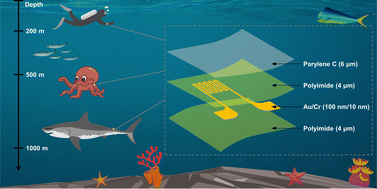
Soft Matter, 2023,19, 5772-5780
https://doi.org/10.1039/D3SM00563A
Crossover behavior in stress relaxations of poroelastic and viscoelastic dominant hydrogels
AFM measurement reveals that two distinct mechanisms determine the crossover phenomenon in the stress relaxation of hydrogels. This contributes to a better understanding of similar mechanical behaviors of cells and tissues.

Soft Matter, 2023,19, 5443-5451
https://doi.org/10.1039/D3SM00592E
Influence of surfactant on glass transition temperature of poly(lactic-co-glycolic acid) nanoparticles
Presented is an experimental study of PVA and DMAB stabilized PLGA particles and the measurement of their Tg's with mDSC.

Soft Matter, 2023,19, 5371-5378
https://doi.org/10.1039/D3SM00082F
Microfluidic nanobubbles: observations of a sudden contraction of microbubbles into nanobubbles
Utilizing a microfluidic flow-focusing chip to generate monodisperse bulk nanaobubbles. We make the surprising observation of a critical microbubble diameter above and below which the scale of bubble shrinkage dramatically changes.

Soft Matter, 2023,19, 5142-5149
https://doi.org/10.1039/D3SM00380A
Investigating the cut-off effect of n-alcohols on lipid movement: a biophysical study
Cellular membranes are responsible for absorbing the effects of external perturbants for the cell's survival.

Soft Matter, 2023,19, 5001-5015
https://doi.org/10.1039/D2SM01583H
Magnetic field enabled in situ control over the structure and dynamics of colloids interacting via SALR potentials
A model system of tunable, competing short-range attraction (SA) and long-range repulsion (LR) among colloidal particles is developed which encompasses a diverse range of assembled states, including fractal clusters and a Wigner glass state.

Soft Matter, 2023,19, 4439-4448
https://doi.org/10.1039/D3SM00354J